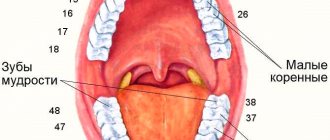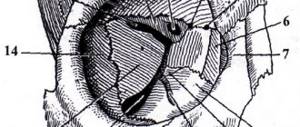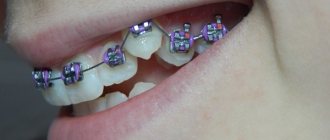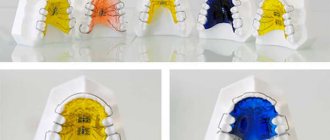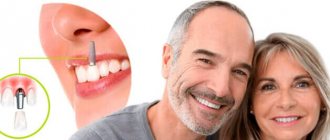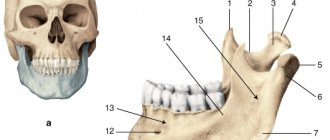5858
Various devices are used to correct jaw abnormalities, one of which is a palatal expander. The device is intended only for expansion of the upper jaw, which occurs due to the expansion of the palatal suture.
Due to the effectiveness of the device, it is used to treat not only children, but also adults.
What does it represent?
A palatal expander is a device prescribed in case of severe narrowing of the jaw , if it cannot be corrected by more gentle methods.
Purpose
The main task of the device is to expand the upper jaw arch, the dimensions of which allow the lower dentition to prevail over the upper one. As a rule, in such a situation, the lower teeth protrude outward in relation to the upper ones.
The device is designed to normalize the relationship of the jaw arches, only in transversal directions, i.e. displacement to the sides from the center line of the sky.
The palatal expander is not able to completely solve orthodontic problems associated with disproportionate jaw growth, therefore it is used as the primary stage of complex orthodontic treatment .
The principle of operation is shown schematically in the following video:
Design
The device is a metal structure consisting of several elements:
- support rings (crowns);
- orthodontic screw to activate the device;
- wire arches.
The design is made in a cross-shaped form, where in the middle there is a locking mechanism with a screw designed to expand the device. From it, the action on the jaw is transmitted through 4 wire arches soldered to the lock.
Each wire is attached to support rings located on the molars. At the ends of the wires there are closed loops, which increase their elasticity and contribute to the shock absorption of the structure.
Let's look at ways to straighten teeth and their effectiveness.
Let's talk about Clarity braces here.
See the photo of a person’s malocclusion https://zubovv.ru/ortodontiya/prikus/nepravilnyiy-foto-i-formyi-litsa.html at the link.
Methods for correcting bites in children
Methods for correcting malocclusion in children can be non-hardware, hardware (orthodontic), surgical and complex.
Non-hardware
This method involves correcting the bite in children without braces. When treating some pathologies, it is quite possible to do without the use of orthodontic appliances. Provided this happens at an early age. The non-hardware method of bite correction includes the following procedures:
- Getting rid of bad habits. These include improper swallowing, sucking of fingers and various objects (handles, nipples, etc.);
- General posture correction;
- In baby teeth, the cusps can be ground;
- If caries is present, treat it in a timely manner;
- Gum massage. It is done during the period of teething and corrects the direction of their growth;
- Elimination of all obstacles to breathing through the nose. Such obstacles may include chronic rhinitis, deviated nasal septum, adenoids;
- Myotherapy.
Myotherapy is special exercises for correcting malocclusion in children. The systematic implementation of them is very important. The positive effect of myotherapy can be in children from 3 to 6 years old, while they have a so-called temporary dentition. The essence of the exercises is to train the muscles of the floor of the mouth, as well as the muscles of facial expression and chewing. Training restores the tone of these muscles required for their normal functioning. This ensures the development and growth of the jaws, and also creates conditions for permanent teeth to erupt correctly. In children over 6 years of age, myotherapy serves as an adjuvant and is combined with other methods (complex and instrumental).
Orthodontic (aka hardware) method
This is the most common method for correcting dental defects and is used in most cases. During the formation of permanent dentition in children after 6 years of age, various types of orthodontic appliances are used, which give the name to the method. An orthodontic appliance for correcting malocclusion in children can perform a variety of tasks. These include:
- Stimulating tooth growth;
- If overdeveloped, tooth growth may be inhibited;
- Jaw shape correction;
- If a tooth is not positioned correctly, the orthodontic appliance can move it.
To correct the bite, braces, plates and orthodontic trainers are used. All devices that correct the position of teeth are divided into 2 groups: removable and non-removable.
A removable device for correcting malocclusion in children is a plastic plate mounted on the jaw. It is made in the laboratory, according to a pre-made individual cast. The plate is held on the teeth by wire hooks. This device can be easily removed to brush your teeth or eat.
For crookedly growing teeth, the removable appliance is supplemented with special devices, whose purpose is to exert a directed force on the tooth. Such a device requires some adaptation, which takes about 2 to 3 weeks.
The advantage of removable devices is that the force of their impact is relatively small. They also do not interfere with oral hygiene procedures. These two factors make removable devices very convenient for performing bite alignment in children. This method of treatment takes longer, but the results are consolidated faster.
As for fixed orthodontic devices, they are basically all standard. A fixed device develops a much greater impact force than a removable one, which can even cause pain. But the time it takes to treat with this type of device is much less. Among the disadvantages, one can note the difficulty of hygiene procedures. If treatment takes place in childhood, the accumulated plaque poses a particular danger. The fact is that at this age, tooth enamel is still in the process of maturation.
Recently, the design of fixed orthodontic appliances has undergone significant changes. This is how modern braces and edgewise techniques appeared. These technologies are today used in many developed countries of the world due to their high efficiency.
Complex method
Complex treatment involves combining two other methods - hardware and surgical intervention. The main age when this method is used is from 6 to 12 years. Complex treatment is used in cases where dental defects are very pronounced. Typically, these defects are associated with disturbances in the eruption of teeth and their size.
Indications and contraindications
Photo: abnormally narrow upper jaw
It is impossible to install an expander simply because of uneven teeth. There is a specific indication for its use: narrowing of the upper jaw with a pronounced deviation from the norm .
In this case, the cause of the narrowing may be underdevelopment of the jaw bones due to:
- bone diseases;
- genetic predisposition;
- endocrine disorders;
- injuries
It should be borne in mind that the younger the patient’s age, the more successful the treatment will be . The most optimal age is childhood, when the jaw bones are easily adjusted.
The device also shows good results when treating adults, but in isolated cases there are no positive changes or a relapse of the primary condition is observed.
In addition to age, before placing a palatal expander, it is necessary to take into account the presence of contraindications that prevent the use of this product:
- inflammation of periodontal tissue;
- the presence of a separately protruding tooth in a crossbite;
- asymmetric crossbite;
- anterior open bite;
- convex face profile;
- skeletal asymmetry of the jaws with anteroposterior and vertical discrepancy.
The presence of the first two contraindications are relative and after eliminating the problem, a palatal expander can be installed for correction.
Microgenia
Microgenia can develop under the influence of the following factors:
- unfavorable heredity
- lower jaw injuries
- inflammatory process in the area of the temporomandibular joint in the area of the lower jaw, suffered in childhood
Micrognathia and microgenia lead, in turn, to crowding of teeth in the dentition, chewing disorders and the formation of malocclusion, many dental and periodontal diseases, as well as serious distortions of the shape of the face.
Micrognathia (underdeveloped upper jaw) is somewhat more common than microgenia (underdeveloped lower jaw).
Advantages and disadvantages
In addition to high efficiency, the palatal expander has some other advantages:
- Speed of correction . As a rule, it only takes a few weeks for the palatal suture to widen.
- Aesthetics . The device is installed on the molars, and the entire structure is located near the palate, which makes it invisible when talking and smiling.
- High quality of fixation , eliminating injury to the mucous membrane.
- Accuracy of the predicted result.
- They do not interfere with hygiene procedures and are easy to clean .
But, despite the positive aspects, the device has significant disadvantages, which place the palatal expander in the category of not the most popular orthodontic devices:
- Bulky design, creating inconvenience in installation.
- During the first time after fixation, the patient experiences a pronounced impairment of swallowing function.
- Injury to the surface of the tongue by the lock mechanism.
- Severe diction disorder.
- Pain during the correction period.
- Increased salivation.
For many, the listed disadvantages are not a serious obstacle to treatment with a palatal expander.
Stages and duration of treatment
Treatment begins with a thorough examination and development of a correction plan. Then proceed to the stage of preparation and fixation of the device:
- Installation of separation rings between molars . They are designed to expand the interdental space between the molars in order to freely place support rings on them in the future. Separation rings are installed for a week, after which the palatal expander is fixed.
- Fixing standard support rings with cement. In some cases, they can be made to order.
- Selecting an orthodontic screw in accordance with the clinical problems being solved.
- The location of the screw is under the palate, at the level of the middle length of the roots of the teeth.
- Fitting the wire arcs of the screw by fixing the loops in the locks of the support rings.
Another installation option can be used, when the structure is formed on a plaster model of the patient’s jaw, and then the finished one is transferred to the oral cavity, fixed with supporting crowns.
The installation procedure ends with activation of the device and training of the patient, since he will carry out the remaining activation procedures independently at home. As a rule, activation is carried out once every 3 days.
During treatment, the patient visits an orthodontist once every 10 days, who monitors the speed of movement and gives recommendations on how to eliminate painful and uncomfortable sensations that appear due to displacement of the jaw bone.
The main sign of expansion is the appearance of wide spaces between the teeth.
, 4–5 weeks of wearing the device are most often . After this, its lock is fixed, but the device is not removed, since the separated palatal suture must be filled with new tissue.
To avoid relapse, the device is worn for at least another month, and then replaced with a brace system.
Installation process
Installation of the Ross apparatus consists of attaching its supporting elements (rings and rods) to the painters and fangs, respectively. The fangs are connected to the rods using a composite and do not require special machining.
To install the rings on the painters, you need to create a gap between the teeth for them. It is obtained by installing a system of separation elastic rings into the proximal space between the supporting molars a week before fixing the system of separation elastic rings. Before installing the device, the separation rings are removed.
The installation procedure itself consists of the following operations:
- Brushing teeth with a rotating brush and toothpaste.
- Washing and drying abutment teeth.
- Applying cement to the support rings and installing the latter on the supporting molars until they stop. Removing excess cement.
- Attaching the rods to the canines using a composite, removing excess material, polymerizing the attachment site with light.
Care instructions
For the hygiene of the palatal expander, it is necessary to follow the same cleaning regimen as for the dentition. Being a complex design, the device promotes the accumulation and proliferation of microbes , which can cause various pathologies of the oral cavity.
To avoid this, it is necessary to clean the device during morning and evening brushing. After each meal, food particles should be carefully removed from it using toothpicks, special threads or brushes.
If you don’t have these devices at hand, you can simply forcefully rinse your mouth with water or mouthwash. A big advantage is the use of an irrigator , which is capable of washing out bacterial plaque from all micro-gaps of the device.
Do you know what you can’t eat with braces and why?
This article states what a pediatric orthodontist treats.
Follow the link https://zubovv.ru/ortodontiya/breketyi/vestibulyarnyie/inspire-ice-podrobnyiy-obzor.html reviews about Inspire Ice braces.
Reviews
Photo: before and after maxillary expansion
Despite the complexity and cumbersomeness of the design, patients leave positive reviews about the palatal expander. They especially highlight the speed of the system .
You can also share your review of this device by leaving it in the comments to this article.
If you find an error, please select a piece of text and press Ctrl+Enter.
tags jaw bite
Did you like the article? stay tuned

